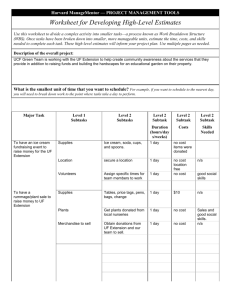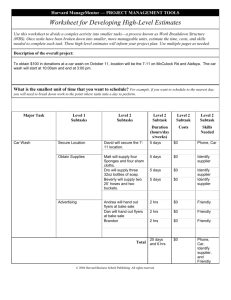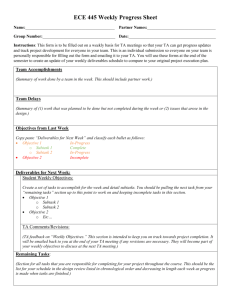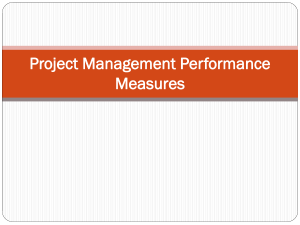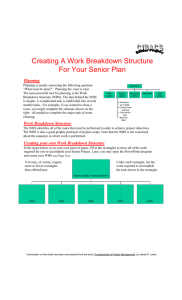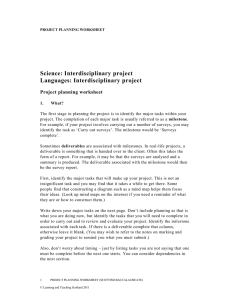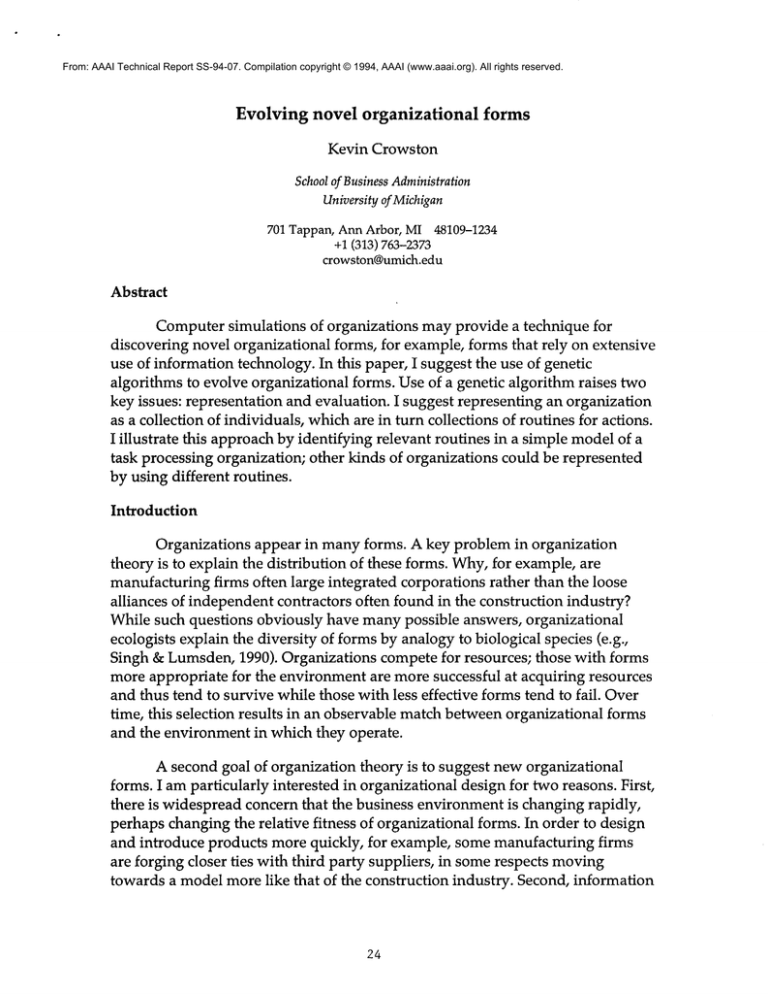
From: AAAI Technical Report SS-94-07. Compilation copyright © 1994, AAAI (www.aaai.org). All rights reserved.
Evolving
novel
organizational
forms
Kevin Crowston
Schoolof BusinessAdministration
Universityof Michigan
701 Tappan, AnnArbor, MI 48109-1234
+1 (313) 763-2373
crowston@umich.edu
Abstract
Computer simulations of organizations may provide a technique for
discovering novel organizational forms, for example, forms that rely on extensive
use of information technology. In this paper, I suggest the use of genetic
algorithms to evolve organizational forms. Use of a genetic algorithm raises two
key issues: representation and evaluation. I suggest representing an organization
as a collection of individuals, which are in turn collections of routines for actions.
I illustrate this approach by identifying relevant routines in a simple model of a
task processing organization; other kinds of organizations could be represented
by using different routines.
Introduction
Organizations appear in many forms. A key problem in organization
theory is to explain the distribution of these forms. Why,for example, are
manufacturing firms often large integrated corporations rather than the loose
alliances of independent contractors often found in the construction industry?
While such questions obviously have many possible answers, organizational
ecologists explain the diversity of forms by analogy to biological species (e.g.,
Singh & Lumsden, 1990). Organizations compete for resources; those with forms
more appropriate for the environment are more successful at acquiring resources
and thus tend to survive while those with less effective forms tend to fail. Over
time, this selection results in an observable match between organizational forms
and the environment in which they operate.
A second goal of organization theory is to suggest new organizational
forms. I amparticularly interested in organizational design for two reasons. First,
there is widespread concern that the business environment is changing rapidly,
perhaps changing the relative fitness of organizational forms. In order to design
and introduce products more quickly, for example, some manufacturing firms
are forging closer ties with third party suppliers, in some respects moving
towards a model more like that of the construction industry. Second, information
24
technology is rapidly changing fundamental constraints on organizations, for
example, by making communication and data storage much cheaper or by
facilitating previously impractical interactions across time or space. These
technical innovations make feasible new organizational forms, some of which
may be more effective than existing forms. There are many examples (in the
popular business press, at least) of new organizational forms driven by
information technology: Batterymarch Investment adopted a novel approach to
investment banking, using a computer instead of research staff to identify
possible investments (Schmerken, 1987).
These two forces--changes in the environment in which firms operate and
expansion of the space of possible forms--suggest that we may be on the brink of
a period of rapid alteration in the punctuated evolution of organizational forms
(Stinchcombe, 1965). A important practical question then is how to search this
expanded design space for possibly useful forms.
One solution, presumably, is to wait and see. In response to these forces,
managers will undoubtedly themselves search for new forms, just as
Batterymarch Investments did. As Hannan and Freeman (1986) suggest, "[m]uch
entrepreneurial activity involves conscious revision of forms and routines to take
advantage of changing opportunities and constraints or to avoid defects in
orthodox designs" (p. 63). While this empirical approach is sure to identify
successful forms, it has several drawbacks. First, it is likely to be quite expensive
and time consuming. Second, while the forms that emerge are by definition
successful, there is no guarantee that all possibly successful forms will emerge.
Finally, it gives managers no advice to help their companies remain viable.
Alternately, we could attempt to predict theoretically what kinds of forms
might be successful. Manyorganizational theories, of course, attempt to do just
this. As originally stated, however, theories of organizational ecology say only
that if the environment changes, new forms may eventual replace existing ones.
These theories describe the processes by which forms emerge, but they provide
little insight into what exactly they might be. Indeed, Romanelli (1991) calls the
question of the origin of new organizational forms "one of the critical
unaddressed issues in organizational sociology".
Fortunately there is a third choice, namely computer simulations (Whicker
and Sigelman, 1991). Researchers in manydisciplines gain insight into complex
behaviours by imagining how a computer could be programmed to reproduce
them (e.g., Simon, 1981). Simulations have a long history in organizational
research; Cyert and March (1963), for example, used this approach. In their
analysis of the processes firms use to makepricing decisions, the "process is
specified by drawing a flow diagram and executing a computer program that
simulates the process in some detail" (p. 2).
25
Using a genetic algorithm to evolve organizational forms
The metaphor of organizations competing and being selected on the basis
of their fitness is a compellingone. As it happens, it is also the basis of a
computer technique knownas the genetic algorithm (Holland, 1992), used
efficiently search large design spaces. A genetic algorithm works as follows.
Given a problem, a random population of possible solutions is generated.
Solutions in the population are evaluated and the most promising ones used in
proportion to their fitness as the basis for the next generation of possible
solutions. Newsolutions are created by cross-over, that is, by taking two existing
solutions, dividing each in two parts and exchanging parts to create two hybrid
solutions. Note that in most genetic algorithms, mutation plays a secondary role.
The process is repeated for some fixed numberof generations or until one of the
solutions successfully solves the problem.
If we can more precisely describe the space of organizational forms, we
can use this algorithm to search it. To apply this technique then, a general model
of what organizations do is necessary. As well, we need to represent the
environment in which the organizations perform and, explicitly or implicitly, a
fitness function to identify "good" organizations. By varying the environment,
we can look for forms that maybe desirable under different conditions.
As a representation, it is interesting to consider howan organization
might be represented as a collection of comps (McKelvey, 1982) or manes (Nelson
& Winter, 1982). These routines can be modelled as rules or productions
indicating the appropriate action to be taken in a situation. For example, a meme
could be represented as a production in a classifier system; such system have
already been successfully used with the genetic algorithm (Holland, 1992). Such
rule-based representation seems particularly appropriate for use with the genetic
algorithm because of the claimed robustness of rule-bases to additions or
deletions of individual rules.
Hannan and Freeman (1986) point out that organizations also have higherorder coordinating routines. Theynote it would be difficult to distinguish (for
example) a public and private university without considering such routines since
the skills and activities of individual faculty would be similar or even
indistinguishable. To be useful, therefore, an organizational model will have to
include both kinds of routines.
As well, we need a mechanismto assess the fitness of individual
organizations. The most straightforward approach to this problem is to choose a
task and measure the success of the organization at performing it (e.g., the time
required to perform the task, numberof tasks performed in unit time, total cost,
etc.). Picking a good task is key--it must be abstract enough to simulate but have
26
clear application to a real situation. Better yet, it should be one that could be done
in manyways, with no clear dominant best form, and for which the features of
the organization of theoretical interest are thought to makea difference in
performance. For example, if we chose to model communication patterns within
an organization, then the task evaluated should be one for which theory suggests
howthose patterns affect the outcome(e.g., by affecting howlong it takes to
perform the task).
Features of the environment also determine in part the fitness of
organizations. As with organizational forms, there are manyfeatures of the
environment that could be represented. Freeman and Hannan (1983), for
example, examined the effects of environmental variability and patchiness. The
features of the environment modelled are those that are presumed to affect the
performance of the organization on the task. In the model of communication
patterns discussed above, likely environmental variables include the cost or
speed of communication.
Example: Task assignment routines in markets and hierarchies
To illustrate the possible applications of these ideas, I will briefly discuss
how routines could be used to represent an organizational model such as
Malone’s (1987) hierarchies and markets. (It seems useful initially to attempt
reproduce findings for which there is some theoretical prediction.) In Malone’s
model, the problem faced by an organization is processing tasks (e.g., building
cars). Tasks are assumed to arrive at some point in the organization but must be
decomposed into subtasks to be processed by other specialized processors. We
may assume that the environment provides some payoff for successfully
completed tasks.
The units to be evolved in this model are the individual actors--the
population of interacting actors composean organization. Each actor starts with
a random selection of routines and connections to other actors. Although Malone
did not describe them in this way, we can analyze each actor’s behaviour as a set
of routines for primitive operations and for interacting with other actors, as
summarized in Figure 1. Malone’s analysis considered only pure organizational
forms and therefore only a limited variety of organizational actors: by mixing
these basic capabilities we maybe able to generate a wide variety of intermediate
foITnS.
In each generation, the behaviour of the actors are simulated and their
interactions determining the performance of the organization. Actors that
contribute to the success of the organization, weighted perhaps by some measure
of their cost to the organization, are then selected and bred to form the next
generation of actors.
27
Using such a model, the effect of changes in underlying parameters could
be assessed. For example, Malone’s models included parameters for various
costs, such as performing a subtask, maintaining a unit of production capacity
and sending a message. By substituting a different set of routines, entirely
different types of organizations can be modelled. For example, Crowston (1991)
modelled the activities performed by participants in engineering change
processes and Pentland (1992) modelled the moves made by software support
hotline specialists.
Conclusion
A major drawback to the approach suggested is apparent difficulty of
implementation. Evaluating any particular organizational form seems to require
simulating its behaviour, which implies an extensive infrastructure for modelling
agents and their interactions. Furthermore, such a simulation is likely to be quite
time consuming and would have be performed at each generation, multiplying
the processing time required. The high degree of interaction between actors in
this model seems to makeit difficult to moveto a parallel architecture. As a
result of these difficulties,
I have not yet implementedthe model, although I am
interested in doing so. Suggestions for approaches to implementation would be
greatly welcomed.
28
Figures
Figure 1. Capabilities of different actor types in Malone’s (1987) model
organizations.
Actor type
Capabilities and knowledge
Processor
Perform assigned subtasks
Respond to bids in a market
Product managers
Decomposetasks into subtasks
Knowone processor for each type of subtask
Communicate with processors to assign subtasks
Integrate results of subtasks
Functional
Knowmultiple processors for one type of subtask
Pick best processor for a given subtask
Communicate with processors to assign subtasks
manager
General manager
Decomposetasks into subtasks
Knowone functional manager for each type of subtask
Communicate with functional manager to assign
subtasks
Integrate results of subtasks
Buyers in a decentralized
market
Decomposetasks into subtasks
Knowmultiple processors for each type of subtask
Request bids for each type of subtask
Evaluate bids to pick best processor for a given subtask
Communicate with processors to assign subtasks
Integrate results of subtasks
Buyers in a centralized
market
Decomposetasks into subtasks
Knowone middleman for each type of subtask
Communicate with middlemen to assign subtasks
Integrate results of subtasks
Middlemen in a
centralized market
Knowmultiple processors for one type of subtask
Request bids for one type of subtask
Evaluate bids to pick best processor for a given subtask
Communicate with processors to assign subtasks
29
References
Crowston, K. (1991). Towardsa Coordination Cookbook:Recipes for Multi-Agent
Action. Unpublished doctoral dissertation, MITSloan School of
Management.
Cyert, R. M. and March, J. G. (1963). A Behavioral Theory of the Firm. Englewood
Cliffs, NJ: Prentice-Hall.
Freeman, J. and Hannan, M. T. (1983). Niche width and the dynamics
organizational change. AmericanJournal of Sociology, 88, 116-45.
Hannan, M. T. and Freeman, J. (1986). Where do organizational
from? Sociological Forum,1(1), 50-72.
forms come
Holland, J. H. (1992). Adaptation in Natural and Artificial Systems (2nd ed.). Ann
Arbor, MI: University of Michigan.
Malone, T. W. (1987). Modeling coordination in organizations
ManagementScience, 33, 1317-1332.
and markets.
McKelvey,B. (1982). Organizational Systematics: Taxonomy,Evolution, Classification.
Berkeley: University of California.
Nelson, R. R. and Winter, S. G. (1982). An Evolutionary Theory of EconomicChange.
Cambridge, MA: Harvard.
Pentland, B. T. (1992). Organizing moves in software support hotlines.
Administrative Science Quarterly, 37, 527-548.
Romanelli, E. (1991). The evolution of new organizational
Sociology, 17, 79-103.
forms. Annual Review of
Schmerken, I. (1987). Expert system churns manyhappy returns.
ComputerReview, 5(3), 14-17.
Wall Street
Simon, H. A. (1981). Studying humanintelligence by creating artificial
intelligence. AmericanScientist, 69(3), 300-309.
Singh, J. V. and Lumsden,C. J. (1990). Theory and research in organizational
ecology. Annual Review of Sociology, 17, 161-193.
Stinchcombe, A. L. (1965). Social structure and organizations. In J. G. March
(Eds.), Handbookof Organizations (pp. 153-193). Chicago: Rand McNally.
30
Whicker, M. L. and Sigelman, L. (1991). ComputerSimulation Applications.
Newbury Park CA: Sage.


